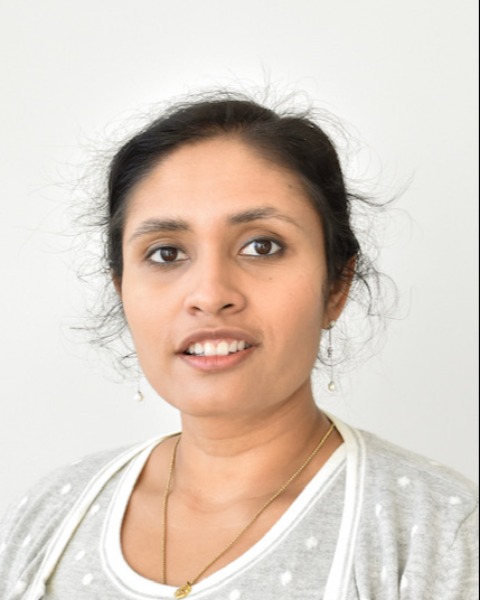Neural Engineering
(J-386) Enriched grey matter astrocytes support greater axon growth of V2a interneurons than enriched white matter astrocytes

Sangamithra Vardhan, MS (she/her/hers)
Graduate Research Assistant
University of Washington
Seattle, Washington, United States- SS
Shelly Sakiyama-Elbert (she/her/hers)
Professor and Vice Dean of Research and Graduate Education in UW School of Medicine
University of Washington, United States
Presenting Author(s)
Primary Investigator(s)
and
that protoplasmic astrocyte-derived ECM supports higher levels of axon growth than fibrous astrocyte-derived ECM [3,4]. However, the astrocytes used in those studies were unpurified, heterogeneous populations, where multiple cell types might have contributed to ECM deposition. The goal of this project is to increase phenotypic purity of ESC-derived astrocytes that are producing the ECM to be studied and better understand the effect of astrocyte phenotype on increasing axon growth.
Materials and Methods::
A novel transgenic mESC line was generated that contained puromycin acetyltransferase (PAC), conferring puromycin-resistance, under control of the aquaporin-4 (Aqp4) promoter. This Aqp4-Puro cell line allowed enrichment of protoplasmic astrocytes. Likewise, a previously generated transgenic mECS line, Olig2-Puro, was used to enrich for fibrous astrocytes [5]. mESCs were placed in media containing retinoic acid (RA) and smoothened agonist (SAG) for 5 days to produce ventral spinal precursors [3]. Following, the exposure of cells to bone morphogenic protein (BMP4) produced protoplasmic astrocytes and to ciliary neurotrophic factor (CNTF) produced fibrous astrocytes [3]. RNA was collected at various time points to evaluate Aqp4, Olig2, and PAC expression via qPCR to determine the time point for puromycin addition. The astrocyte selection consisted of 2 and 4 µg/mL of puromycin being added to protoplasmic and fibrous astrocytes, respectively. Selected and unselected astrocyte phenotypic cultures were analyzed for protein expression of various markers using immunocytochemistry to determine presence of neurons and undifferentiated stem cells. The astrocyte phenotypes at day 27 were also tested as live astrocyte substrates for potential support of V2a interneurons. In addition, frozen astrocytes were obtained by storing day 27 astrocytes in the freezer for one day and decellularized astrocytes were obtained by using a modified Hudson’s protocol on day 27 astrocytes [3,4,6]. V2a interneurons derived from a selectable Chx10-PAC td-tomato cell line to help visualize axon growth on the various astrocyte substrates and the axon growth was analyzed as average neurite length using MATLAB pipeline [7].
Results, Conclusions, and Discussions::
Gene expression analysis by qPCR showed that PAC expression peaked at day 17 for Aqp4-Puro protoplasmic astrocytes, while later time points had high Olig2 expression for Olig2-Puro fibrous astrocytes. Selected cultures showed a statistically marked reduction in neurons and decrease in other cell types such as undifferentiated stem cells and oligodendrocytes (Figure 1A). In addition, immunocytochemistry showed proper astrocyte phenotypic morphology post-selection though using glial fibrillary acidic protein (GFAP) staining. General astrocyte markers also have Furthermore, flow cytometry quantification showed high double positive Aqp4 and A2B5, a ganglioside surface marker on astrocytes, for selected fibrous astrocytes and low double positive Aqp4 and A2B5 for selected protoplasmic astrocytes. It was shown that selected astrocyte phenotypic differences in supporting axon growth of V2a interneurons were observed with selected protoplasmic astrocyte substrate components, such as ECM, supporting more than that of selected fibrous (Figure 1B).
: Day 17 selection of protoplasmic astrocytes and Day 19 selection of fibrous astrocytes with 2 and 4 µg/mL puromycin, respectively produces enrichment of the astrocyte phenotypes derived from mESCs. There is reduction of other cell types shown by the decreased presence of other cell-specific markers and some increase in general astrocyte markers. Furthermore, selected protoplasmic astrocytes support more axonal growth than selected fibrous astrocytes in all components of astrocytes specifically decellularized substrates. In future, we hope to utilize bulk RNA-sequencing and proteomics to identify axon growth promoting genes and proteins in selected protoplasmic astrocytes that can aid in developing therapies that promote locomotor and respiratory functions post-SCI for patients.
Acknowledgements (Optional): :
References (Optional): : [1] National Spinal Cord Injury Statistical Center, University of Alabama at Birmingham. 2023. [2] Ahuja, C. Neurosurgery. 2017;80(3S), S9-S22. [3] Thompson, R. E. Stem Cell Dev. 2017; 26(22), 1597-1611. [4] Thompson, R.E. Biomaterials. 2018;162, 208-223. [5] McCreedy, Dylan A. Stem cell research. 2012; 8.3, 368-378. [6] Hudson. Tissue Eng, 2004; 10, 1346–1358 [7] Iyer, N.R. Experimental neurology. 2016; 277, 305-316.
